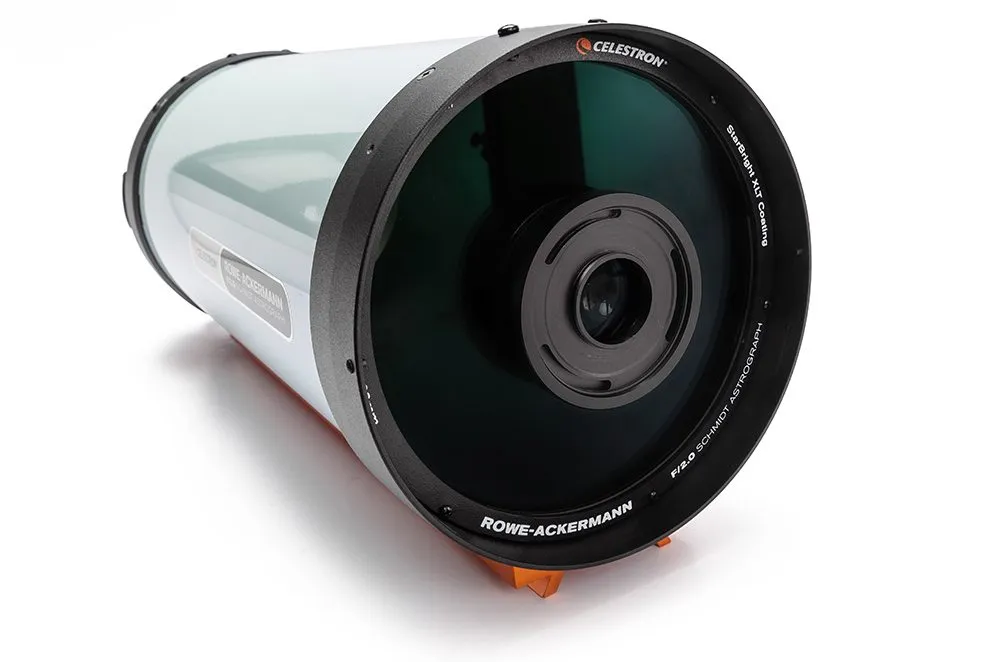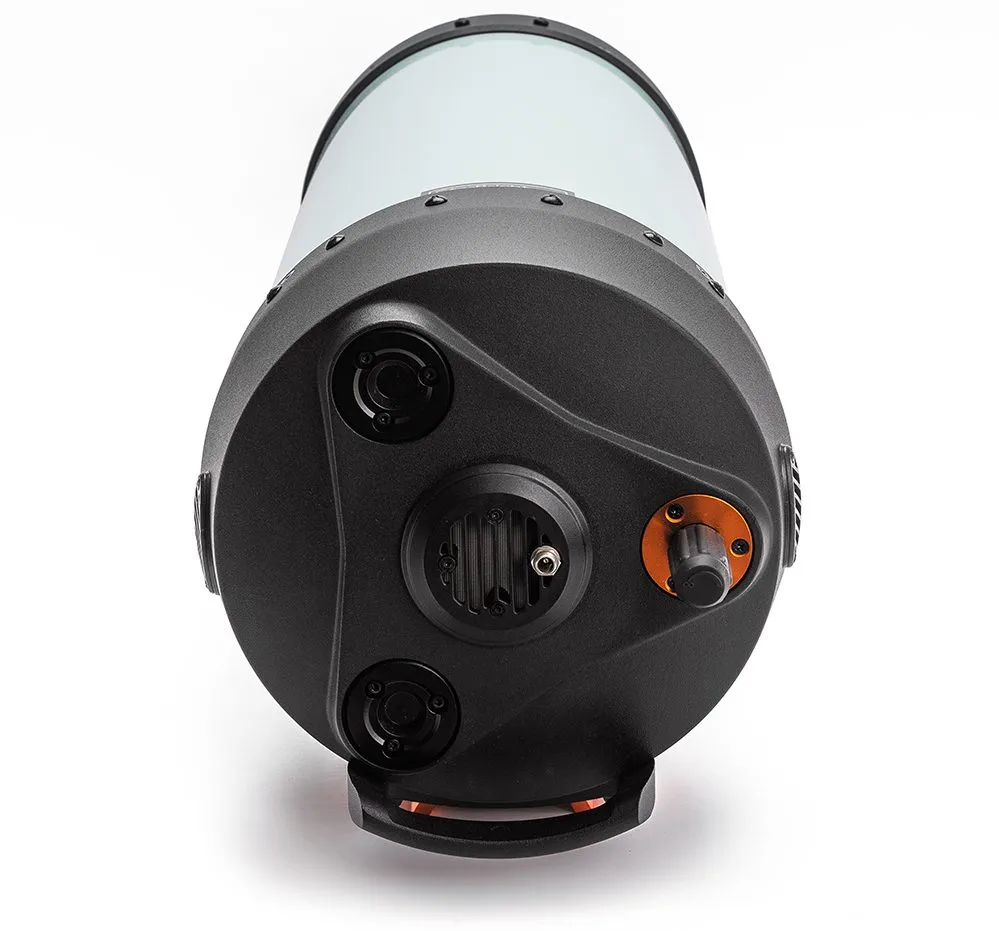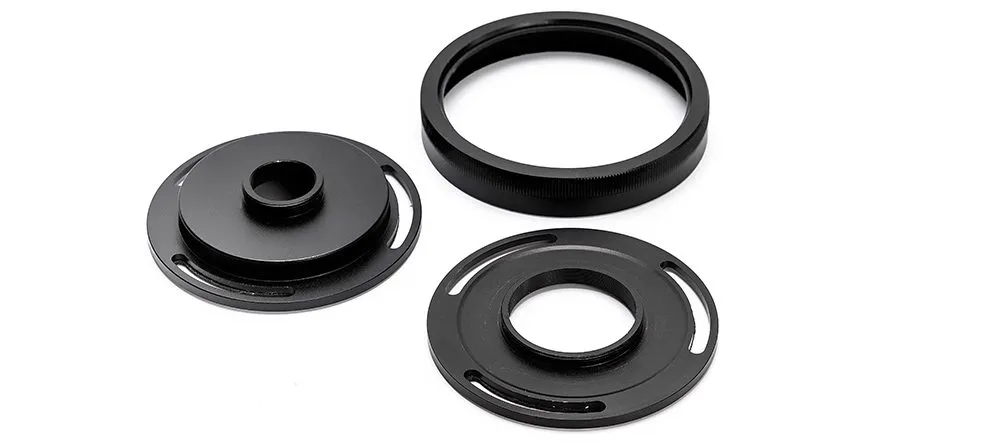The Celestron RASA-8 is a telescope designed solely for astrophotography. RASA stands for Rowe -Ackermann Schmidt Astrograph.The Schmidt part is commonly heard in connection with Schmidt-Cassegrain telescopes (SCTs) and refers to a design introduced by Bernhard Schmidt in 1930, which uses a fast primary mirror and a front corrector plate.
The corrector plate (aspheric lens) adjusts incoming light so that spherical aberrations in the primary mirror are compensated for.
Celestron produce several RASA instruments, including the RASA-8 (203mm aperture), RASA-11 (279mm aperture) and RASA-14 (356mm aperture).
The RASA design represents a further refinement introduced by astronomers and optical experts David Rowe and Mark Ackermann.
Here the converging light cone additionally passes through a 4-element rare-earth lens group mounted where you would expect to find the secondary mirror in a conventional SCT.
This telescope is among our pick of the best telescopes for astrophotography

Rare earth elements are used in lens manufacture because of their low dispersion properties, which helps minimise colour fringing.
The RASA’s flat focal plane sits in front of the corrector.
The result is an aberration free, colour-corrected image, which delivers full illumination and pin-sharp stars over a 22mm image circle with only minimal performance loss over a 32mm-image circle.
Need for speed
The RASA also has an impressive optical speed. This is a comparative value used to indicate how quickly an exposure of certain depth can be achieved.
In astronomy, the speed of a telescope is also known as its focal ratio. It can be determined by dividing the scope’s effective focal length by its aperture using the same units.
The RASA-8 has an effective focal length of 400mm and an aperture of 203mm, hence its focal-ratio is f/2.
In the world of astrophotography f/2 is fast, indicating the RASA-8 can deliver seriously deep sky images in a short time.
As an example, an f/2 system delivers images of the same exposure depth as an f/10 system in just a twenty-fifth of the time.
Focus issues
There are negatives that need mentioning.
No finder is included which, considering the price of the instrument, seems mean. Also, DSLRs aren’t compatible because focus cannot be achieved.
However, Canon and Sony mirrorless models (APS-C or full-fame) should be fine.
Various adaptors are available for different camera threads, but some cameras require spacers to get them into the correct focus position.
The RASA-8 has 25mm back focus from the camera adaptor ring, so if the distance from the camera’s front aperture to the sensor is greater than this, as is the case with a DSLR, focus isn’t possible.
The RASA-8’s limited back focus precludes the use of regular filter wheels, which are used in RGB (red, green and blue) or narrowband imaging.
A Baader low-profile filter holder is now at the prototype stage, with a release expected later in 2019.
Its use will require a camera with a maximum back focus distance of 13mm.
Nevertheless, focusing was precise and the on-axis nature of the front-mounted camera made mount balancing easy too.
We were impressed with the depth we could get with short exposures.
Using an Atik 314L+ cooled CCD camera (11mm diagonal sensor), we reached mag. +15 in just one second.
Under less than perfect skies we were able to record mag. +17.5 galaxies with 30 second exposures.
A 30 second image of the Leo Triplet – M65, M66 and NGC 3628 – provided detail in each galaxy.
It was good to see the entire triplet fitting in the delivered 60x90 arcminute image frame.
We really enjoyed using this scope as it’s light and easy to handle.
In addition, its fast optical speed and relatively wide-field capability make it ideal for setups where alignment isn’t extremely precise.
In this respect it’s an amazing grab-and-go deep sky instrument.
The F/2 optics advantage
The ultimate question is whether the RASA design works.

Does it deliver a flat, well-illuminated field and does it deliver it quickly despite the light blockage from an attached camera?
The answer is a resounding yes, it does its job as described and we can say with confidence that this is a serious contender in the field of astrophotography.
Stars appeared sharp right to the edge of our test frames and we detected no anomalous issues when bright stars were in the field either.
The optics are also optimised to focus across a wavelength range of 390–800 nanometres, which is excellent.
The f/2 system is impressive, allowing you to get very deep images quickly.
The RASA’s wide-field is perfect for large deep-sky objects or clusters of objects such as galaxies.
Combined with the fast optics, this is a scope which is very forgiving of tracking issues; a perfect portable scope for deep sky imaging.
This is echoed by the RASA’s simplicity – once pointed, tracked and focused, all you need do is sit back, relax and watch your masterpiece unfold.
Fan cooling
Like any enclosed telescope tube, the RASA-8 needs to be left to cool so its temperature matches its surroundings.

A dry-cell battery pack can be plugged into the rear of the mirror cell, which powers fan cooling for faster thermal equalisation.
Ultra-Stable Focus System (USFS)
SCTs are focused by turning a focus knob that moves the primary mirror back and forth.
However, early focus designs suffered from miror shift, which caused the image to move depending on which way the focus knob was being rotated.
The RASA design eliminates this issue with a new ‘ultra-stable focus system’.
Optical tube
The optical tube assembly is robust and well made.
The main tube is constructed from aluminium, which – combined with the relatively small size of the RASA-8 – makes the scope very manageable.
The carry handle at the rear of the instrument made handling the RASA-8 very easy.
CGE dovetail bar
The RASA tube has a CGE dovetail bar that runs along the full length of the optical tube.
This bar is compatible with Celestron CGE mounts as well as the popular Losmandy-style dovetail clamp.
A safety knob is provided to prevent the tube from slipping down and out of the clamp.
Camera adaptors
Cameras fit to the telescope via adaptor rings.

Two are supplied as standard – M42 and C-type. The adaptor ring fits inside a threaded collar which can be screwed onto a projecting thread on the front-centre of the corrector plate.
In terms of photographic cameras, it’s worth noting that regular DSLRs are not supported but some mirrorless-models are.
Vital stats
- Price £1,849
- Optics Rowe Ackermann Schmidt
- Aperture 8-inch (203mm)
- Focal length 400mm (f/2)
- Focuser Ultra stable focusing system
- Extras M42 camera adaptor, C-thread camera adaptor, fan battery pack
- Weight 7.7kg (17lbs)
- Dimensions 628x235mm
- Supplier Celestron UK (David Hinds Ltd)
- Tel 01525 852696
- www.celestron.co.uk
This review originally appeared in the June 2019 issue of BBC Sky at Night Magazine
